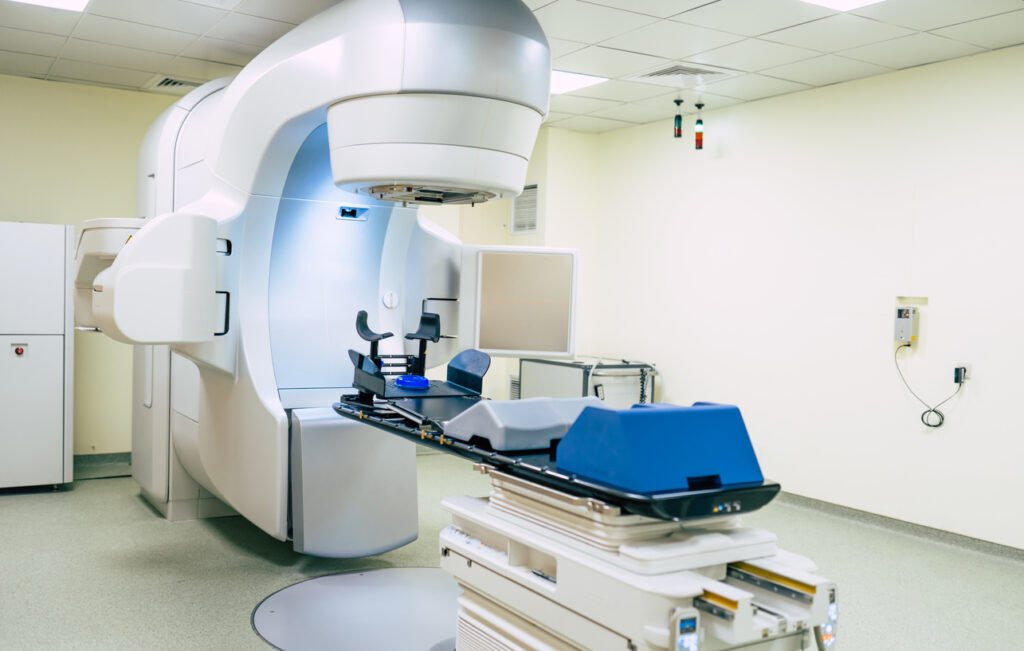Third Party Servicer Coming to Town?
Note: This article was originally published in the October 2023 issue of InterActions (see page 23), the medical physics newsletter of the Canadian Organization of Medical Physicists (COMP) and the Canadian College of Physicists in Medicine (CCPM), and is reprinted with permission.

A medical linear accelerator used in cancer treatment.
At some point, regardless of whether you perform in-house servicing, a third-party individual will be at your facility to service your Class II Prescribed Equipment (CII PE).
Although these third-party service providers will not be working under your Canadian Nuclear Safety Commission (CNSC) licence, you, as owner of the facility, are obligated to ensure the safety of the individual(s) performing the work, the security of your radioactive materials, and the completeness of the work being performed. These obligations fall within three broad time periods: before they arrive, while they are on site, and after they leave.
Before they arrive
The first and easiest step is to ensure the individual(s) will be working under a valid CNSC licence that allows them to work on the make and model of the CII PE being serviced. While this is normally not an issue, if the device is new to the market, the service provider may not have it listed on their licence. Since the CNSC’s service standard for a simple amendment is three weeks, it is worth looking into this when you schedule your service visit.
The second step is to obtain the names and qualifications of the individual(s) who will be performing the service work. The qualifications can include, but aren’t limited to, any training they have received in servicing the equipment, any radiation safety training, and any other relevant qualifications (like a Transportation of Dangerous Goods certificate).
If the person is going to have access to CII PE that contains a category 1 to category 3 source, additional security checks are required. Specifically, the trustworthiness and reliability verifications must be consistent with your site security plan requirements. These verifications are not required if the individual will always be supervised.
While they are on site
After arriving, but prior to them performing any work, the identity of the individual should be confirmed by asking to see the identification issued by their employer. Ensure that the name and photo match the individual, and that the identification card has not expired.
Since no two radiotherapy facilities are identical, the service person should be given a familiarization tour of the bunker in which they will be working. This should consist of showing them the layout and functionality of the safety systems, reviewing the emergency contact information and procedures, and highlighting any other relevant safety information specific to that facility. Documenting the completion of this familiarization tour is highly recommended.
Most third party servicing staff arriving to your site will bring a personal dosimeter issued by their employer. It is good practice to issue them an electronic personal dosimeter, as this ensures doses received at your facility are recorded. This could save you a future headache if their thermoluminescent dosimeter (TLD) receives a high exposure at another location, since you would be able to demonstrate it was not from working on your CII PE.
Often, the requirements listed on the service provider’s licence and the host facility’s licence will overlap but not match entirely. When this happens, the service provider should be instructed to follow the more restrictive procedures to ensure compliance with both CNSC licences.
This may come as a surprise, but the verb “operate” is not on the list of licensed activities for third party servicing licences. This means servicing staff working under such a licence are not allowed to operate the CII PE at your facility without having received the appropriate training and authorization. Should the CII PE need to be operated during the service visit, it must be done by someone from your organization who is authorized to do so. Alternatively, the third-party individual could complete your requirements for authorization to operate the CII PE themselves.
After they leave
After the service work is finished, you must ensure that complete and accurate service records are provided. Even though you are not the one doing the work, it is important to maintain a record of what repairs and maintenance were performed on your CII PE. Note that your annual compliance report must include all service work performed on your CII PE during the reporting period, including work done by third party servicing staff.
Conclusion
The purpose of this document was to give a high-level overview of a licensee’s requirements when a third-party individual is servicing their CII PE. If you have any specific questions I haven’t addressed, please feel free to reach out to the CNSC project officer responsible for your licence(s), and they will be happy to help.
 Jon Aro
Jon Aro
Jon was recently hired as a project officer in the Accelerators and Class II Division at the Canadian Nuclear Safety Commission. He brings with him 18 years of radiation protection experience in a hospital environment, including as the radiation safety officer for a cyclotron and isotope processing facility. In addition to his boyish good looks and relentless charm, he says he is known for his exceptional humility.
Do you want to read more articles like this?
The Bulletin is published by the Canadian Radiation Protection Association (CRPA). It’s a must-read publication for radiation protection professionals in Canada. The editorial content delivers the insights, information, advice, and valuable solutions that radiation protection professionals need to stay at the forefront of their profession.
Sign up today and we’ll send you an email each time a new edition goes live. In between issues, check back often for updates and new articles.
Don’t miss an issue. Subscribe now!
Subscribe

 Jon Aro
Jon Aro
